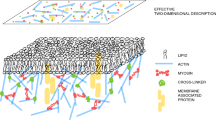Summary
Ultrastructural and immunocytochemical studies allow the localization and identification of a microfilament cortex in heat-shockedAmoeba proteus at different stages of recovery to room temperature. Immediately after heating the cortex is in close contact with the cytoplasmic face of the plasma membrane; however, during cooling it detaches from the membrane and shifts toward the cell centre thus separating a region of peripheral hyaloplasm from central granuloplasm. After polymerization of a new submembrane cortex several detachment and reformation cycles rhythmically repeated for 2–3 hours until a multitude of stratified layers has been formed in the hyaloplasm.
Electron micrographs reveal that the cortical layer at the plasma membrane is merely composed of a network of actin filaments, whereas the retracted contractile layers in the hyaloplasm and at the granuloplasmic border contain both, thick and thin filaments often arranged in bundles. The heat-shock induced activities of the microfilament cortex are based on the highly contractile properties of this system in conjunction with controlled displacements in the equilibrium between F- and G-actin.
Similar content being viewed by others
References
Albanesi JP, Fujisaki H, Hammer JA, Korn ED, Jones R, Sheetz MP (1985) MonomericAcanthamoeba myosin I supports movementin vitro. J Biol Chem 260: 8649–8652
Allen RD (1968) Differences of a fundamental nature among several types of amoeboid movement. Symp Soc Exp Biol 22: 151–168
— (1973) Biophysical aspects of pseudopodium formation and retraction. In:Jeon KW (ed) The biology of amoeba. Academic Press, New York London, pp 201–247
—,Cowden RR (1962) Syneresis in amoeboid movement: its localization by interference microscopy and its significance. J Cell Biol 12: 185–189
Boyles JK, Fox JEB, Phillips DR, Stenberg PE (1985) Organization of the cytoskeleton in resting, discoid platelets: preservation of actin filaments by a modified fixation that prevents osmium damage. J Cell Biol 101: 1463–1472
Bruce DL, Christiansen R (1965) Morphologic changes in the giant amoebaChaos chaos induced by halothane and ether. Exp Cell Res 40: 544–553
Comly LT (1973) Microfilaments inChaos carolinensis. Membrane association, distribution, and heavy meromyosin binding in the glycerinated cell. J Cell Biol 58: 230–237
D'Haese J, Komnick H (1972) Fine structure and contraction of isolated muscle actomyosin. II. Formation of myosin filaments and their effect on contraction. Z Zellforsch 134: 427–434
Goldacre RJ (1952) The action of general anaesthetics on amoebae and the mechanism of the response to touch. Symp Soc Exp Biol 6: 128–144
Grebecka L (1982) Local contraction and the new front formation site inAmoeba proteus. Protistologica 18: 397–402
Grebecki A (1986) Recovery of cytoskeletal and motor capacities by the hyaline blebs produced byAmoeba proteus. Acta Protozool 25: 153–165
—,Kwiatkowska EM (1988) Dynamics of membrane-cortex contacts demonstratedin vivo inAmoeba proteus pretreated by heat. Eur J Protistol 23: 262–272
Guindon A, Couillard P (1964) Localisation par histochimie de l'ATPase de type myosine chezAmoeba proteus. Rev Can Biol 23: 123–128
Haberey M, Stockem W (1971)Amoeba proteus: Morphologie, Zucht und Verhalten. Mikrokosmos 60: 33–42
Hellewell SB, Taylor DL (1979) The contractile basis of ameboid movement. VI. The solation-contraction coupling hypothesis. J Cell Biol 83: 633–648
Kasai M (1969) Thermodynamical aspect of G-F transformations of actin. Biochim Biophys Acta 180: 399–409
Klopocka W, Grebecki A (1982) Locomotion ofAmoeba proteus after standardizing its body shape. Protoplasma 112: 37–45
-Stockem W, High temperature-induced changes in the organization of the microfilament system and the cell membrane stability inAmoeba proteus. Eur J Protistol 24, in press
Korohoda W, Stockem W (1975) On the nature of hyaline zones in the cytoplasm ofAmoeba proteus. Microsc Acta 77: 129–141
Landau JV, Zimmermann AM, Marsland DA (1954) Temperature-pressure experiments onAmoeba proteus plasmagel structure in relation to form and movement. J Comp Cell Physiol 44: 211–232
Marsland DA (1956) Protoplasmic contractility in relation to gel structure: temperature pressure experiments on cytokinesis and amoeboid movement. Int Rev Cytol 5: 199–227
Nermut MV (1982) The “cell monolayer technique” in membrane research. Eur J Cell Biol 28: 160–172
Shäfer-Danneel S (1967) Strukturelle und funktionelle Voraussetzungen für die Bewegung vonAmoeba proteus. Z Zellforsch 78: 441–462
Seravin LN (1966) Ameboid locomotion I. Arrest and resumption of the ameboid locomotion under some experimental conditions (in Russian). Zool Zhurn 45: 334–341
Spurr AR (1969) A low-viscosity epoxy resin embedding medium for electron microscopy. J Ultrastruct Res 26: 31–43
Stockem W, Hoffmann HU (1986) Microfilament organization and function inAmoeba proteus. Acta Protozool 25: 245–254
—,Hoffmann HU, Gawlitta W (1982) Spatial organization and fine structure of the cortical filament layer in normal locomotingAmoeba proteus. Cell Tissue Res 221: 505–519
Webster RE, Osborn M, Weber K (1978) Visualization of the same PtK2 cytoskeletons by both immunofluorescence and low power electron microscopy. Exp Cell Res 117: 47–61
Wohlfarth-Bottermann KE (1964) Cell structures and their significance for ameboid movement. Int Rev Cytol 16: 61–131
Zimmerle CT, Frieden C (1986) Effect of temperature on the mechanism of actin polymerization. Biochemistry 25: 6432–6438
Author information
Authors and Affiliations
Rights and permissions
About this article
Cite this article
Klopocka, W., Stockem, W. & Grebecki, A. Fine structure and distribution of contractile layers inAmoeba proteus preincubated at high temperature. Protoplasma 147, 117–124 (1988). https://doi.org/10.1007/BF01403339
Received:
Accepted:
Issue Date:
DOI: https://doi.org/10.1007/BF01403339




